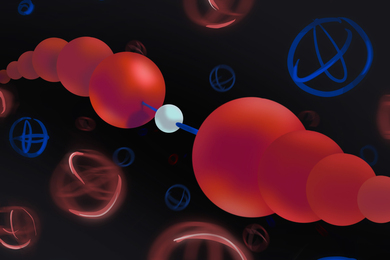Genetic engineers Herbert Boyer and Stanley Cohen are the co-recipients of the 1996 Lemelson-MIT Prize of $500,000 for American invention and innovation.
Together, Drs. Boyer and Cohen laid the cornerstone for modern biological and medical science by inventing a method of cloning genetically engineered molecules in foreign cells. Their discovery paved the way for the mass production of hormones and other chemicals once only made by the human body, and established the multibillion dollar biotechnology industry.
The announcement was made April 11 at the New York Academy of Sciences in New York City by Dr. Lester C. Thurow, the Lemelson Professor at the Sloan School of Management and chairman of the Lemelson-MIT Prize Board, which oversees the selection process. Independent inventor Dr. Jerome H. Lemelson and his wife, Dorothy, established the Lemelson-MIT Prize Program at MIT in 1994 to recognize the nation's most talented inventors and to promote positive role models for American youngsters. The program's $500,000 prize-the world's largest single prize of its kind-celebrates excellence in creativity, invention and innovation.
"The ingenuity of Dr. Boyer and Dr. Cohen has revolutionized the way all of us live our lives," said MIT President Charles M. Vest. "Their collaborative effort-a bringing together of the talents and findings of two laboratories in the pursuit of a third solution-is the stuff of true innovation."
Professor Thurow called Drs. Boyer and Cohen "the fathers of the biotechnology industry. Their contributions to science and society have not only given us the tools to forge our own future, but also provided thousands of jobs for Americans."
"Dr. Cohen and I were hoping to solve a puzzle," Dr. Boyer said, commenting on the prize. "Our curiosities and drive to take our research one step farther made bringing our technologies together seem natural; I'm glad that quest to find a better way is being recognized with the Lemelson-MIT Prize, and I hope it inspires others to do the same.
"We didn't set out to invent genetic engineering," Dr. Cohen continued. "Our invention came from efforts to understand basic biological phenomena and the realization that our findings had important practical applications."
Their collaboration began in November 1972 in Hawaii, where they were both presenting papers at a meeting on bacterial plasmids-circular DNA segments that confer antibiotic resistance to an ever-growing number of bacterial species. Plasmids can also carry genes for a number of other properties that confer a biological advantage to cells containing the plasmid.
Dr. Cohen, then an associate professor of medicine at Stanford University, wanted to understand which genes were present on plasmids, and how they functioned to make bacteria resistant to antibiotics. In his research he had developed a method for introducing plasmid DNA into E. coli bacteria and propagating the DNA in the new cells. By using genetic and biochemical tricks he was able to isolate and clone specific regions of plasmids, he reported at the Hawaii meeting.
Meanwhile Dr. Boyer, a biochemist at the University of California at San Francisco, was trying to understand how cells were able to pick out, from an entire strand of DNA, one specific DNA sequence-when a cell needs to make a specific protein, how does it choose the one DNA sequence that codes for the right protein? A graduate student in his lab found a new enzyme that seemed to cleave the DNA at just the right place. This enzyme, called a restriction enzyme, cut the strand only where it found a particular DNA sequence. In Hawaii, Dr. Boyer described how restriction enzymes yielded DNA segments with "cohesive ends"-ends that could stick to other pieces of DNA.
They both realized that Dr. Boyer's enzyme could provide Dr. Cohen with a valuable tool: one that would cut the plasmid DNA into specific rather than random segments, then bind those segments to new plasmids. "In other words," Dr. Cohen recalled, "it might be possible to use the plasmid as a vector or vehicle for cloning individual DNA segments."
"America's greatest natural resource remains American ingenuity," Mr. Lemelson said. "I can think of few who personify this truism better than Herbert Boyer and Stanley Cohen, who prove that new technologies frequently lead to more jobs and higher living standards."
-------------------------------------
Pacemaker inventor also cited
Wilson Greatbatch, inventor of the implantable cardiac pacemaker, was selected to receive the Lifetime Achievement Award in the Lemelson-MIT Awards Program. Mr. Greatbatch holds 150 patents and is the founder of nine companies.
Cited as "an inspiring role model for aspiring innovators," Mr. Greatbatch said he has enjoyed the work of inventing. "Just immerse yourself in the problem and work hard. The true reward is not in the results, but in the doing."
In 1983 the pacemaker was chosen by the National Society of Professional Engineers as one of the 10 greatest engineering contributions to society in the past 50 years.





